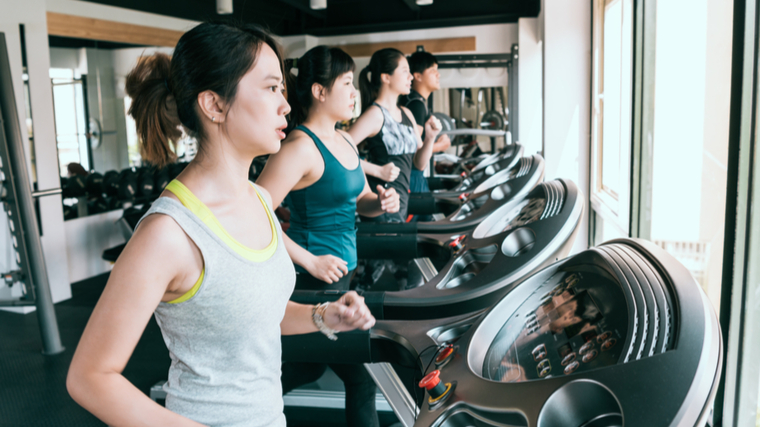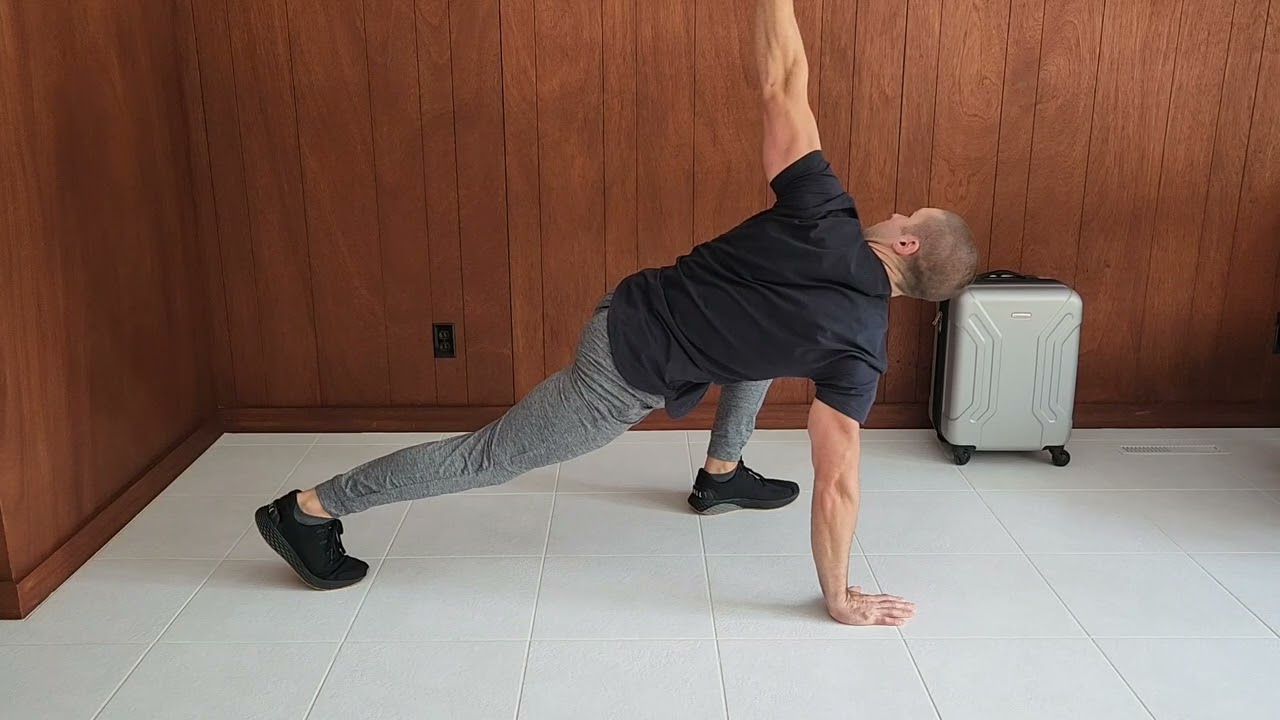When it’s time to hit the gym, most people instinctively gravitate toward hitting the weights. That’s certainly an understandable course of action, since weight training plays a role in everything from muscle-building and strength gains to fat-burning and even heart health.
However, for maximum results toward any of those goals — physique, performance, or health — a comprehensive training plan which includes cardiovascular training has shown to be more effective than treating weight training and cardio as either/or. (1)(2)

That means making time to get outside or, for some weatherproofing, hopping on the old reliable treadmill. While treadmill workouts often bring the dread of slow, painful slogs while staring at the gym’s TV monitors, you can get a more effective workout done in less time when you crank up the intensity with interval training. Here are a few detailed workouts to make your next treadmill session a more productive and (relatively) more enjoyable experience.
HIIT Treadmill Workouts
HIIT Treadmill Workout for Fat Loss
For many people in the gym, once they make the decision to drop some body fat, hopping on the treadmill is often considered par for the course, along with cutting calories and skipping desserts. Rather than logging mile after foot-numbing mile, you can crank up the fat-burning by applying high-intensity intervals to your next treadmill session. Interval training has been shown to be more efficient and more effective than steady state cardio programming. (3)
Speed Intervals
This is one of the most common ways to perform an interval-based treadmill workout. Alternating periods of high-intensity, fast-paced running with low-intensity, slower paced walking allows you to effectively balance output with recovery for an efficient training session.
Because “fast pace” and “slow pace” are relative to your own ability, use your judgment when setting the treadmill speed. Aim for a strenuous run, not necessarily an all-out sprint, on the fast portion. Use a significantly slower pace, typically an easy jog or quick walk, for recovery periods.
With this approach to intervals, you have two potential avenues of progression. You can add more interval periods to increase the overall training time. This makes the workout progressively longer, but also increases the amount of work you’re doing in each session.

You can also keep the same number of intervals while gradually reducing the rest period in each “set.” By reducing the rest by 10 to 15 seconds per week, you’re asking your body to maintain high output with submaximal recovery. This increases the overall training intensity. Both methods can be effective, and they can be used sequentially — reduce rest periods each week for two or three weeks and then begin adding intervals once per week.
This workout can be performed two to four times per week, on non-consecutive days for better overall recovery. Don’t perform the workout immediately after training legs with weights due to potential cumulative fatigue in hip, knee, and ankle stabilizers.
Treadmill Interval
- How to Do it: Set the treadmill to a very low incline (between one and three percent). Steadily increase the speed up to your fast pace. Begin watching the clock as soon as you reach your ideal speed and maintain for the desired period. After you’ve reached the target time for the fast period, steadily decrease the speed and maintain the slow pace for the desired time.
- Sets and Reps: 10 “sets” of 30 seconds at a fast pace and 60 seconds at a slow pace. 15 minutes total training time.
- Rest time: No rest between intervals.
HIIT Treadmill Workout for Conditioning
Improved conditioning, sometimes synonymous with endurance or cardiovascular health, can be a welcomed side effect of most types of treadmill workouts. You can adjust the training for a more efficient and more specific conditioning benefit by taking a strategic approach to the interval treadmill session.
On/Off Treadmill Circuit
This circuit-based treadmill workout may appear unconventional, but it delivers total-body conditioning and a high intensity session which has shown to be more effective than moderate-paced cardio workouts. (4) Rather than alternating active periods of fast running with recovery walking periods, this approach alternates steady (submaximal) runs with more traditional exercises using bodyweight movements or dumbbells (for convenience). You’re essentially “supersetting” a treadmill run with a conventional exercise.
Rather than taking a stationary rest period or walking at a low intensity to recover, the exercise acts as a type of “active recovery” from the hard run. This allows you to continue training while you catch your breath as your cardiovascular system recovers.
This plan requires a bit of coordination, because you’ll be getting on and off the treadmill repeatedly (as the workout’s name implies). It also requires a little bit of planning and, ideally, some extra space near the treadmill itself to safely perform the non-treadmill exercise.

This workout can be adjusted to incorporate a variety of exercises to train a larger array of muscle groups. Choose one exercise for each muscle and perform them in an alternating fashion: treadmill, first body part, treadmill, second body part, treadmill, third body part, etc.
This method can also be performed in a more basic manner focusing on a single body part for the entire session, using a different exercise in each interval. This method can work especially well with ab exercises, turning the session into a “two-for-one” cardio and ab workout.
For safety’s sake, avoid using lower body exercises such as squats or lunges because excessively fatiguing the leg muscles can increase the risk of running-related injuries. Regardless of the body part trained, avoid reaching absolute muscular failure. Doing so will create unnecessary systemic stress and impact recovery. Perform this workout two to three days per week.
Treadmill Run
- How to Do it: Set the treadmill to a very low incline (between one and three percent). Gradually increase the speed until you reach a moderately challenging pace — faster than an easy jog but less than a hard sprint. Maintain the pace for the duration of the set before decreasing the speed. If you can safely dismount the treadmill as it continues moving at a very slow speed, it may be easier to begin the next interval. Safety is paramount, so if you need to stop the treadmill completely between intervals, do so.
- Sets and Reps: 12-16 “sets” of one minute.
- Rest time: No rest before moving to the next exercise (alternate exercises with each interval).
Push–Up
- How to Do it: Drop into a classic push-up position with your hands and toes on the ground, and your hands just outside shoulder-width. Keep a straight line throughout your body. Don’t allow your hips to drop to the ground or spike up to the ceiling. Bend your arms to lower your body while aiming your elbows toward your feet rather than toward the walls to your sides. Move at a relatively slow pace with total control. Descend as low as possible before pressing to full lockout.
- Sets and Reps: 6-8 x 10-12
- Rest time: No rest before returning to the treadmill.
Two-Dumbbell Dumbbell Row
- How to Do it: Stand with a dumbbell in each hand hanging at your sides. Hinge forward at the waist while keeping your back straight and your knees slightly bent. Keep your hands facing each other throughout the movement. Drive your elbows up and back until the weights nearest your thumbs are close to your ribs. Pause briefly before lowering to a full stretch.
- Sets and Reps: 6-8 x 8-10
- Rest time: No rest before returning to the treadmill.
HIIT Treadmill Workout for Beginners
Whether you’re new to the gym or just new to cardio training, you can’t always dive right into an intense workout. However, you can still use HIIT to get familiar with the training method while building a base of conditioning and general fitness.
Incline Intervals
Rather than alternating fast-paced running with slower walking, this approach uses an underappreciated benefit of the treadmill — the incline feature. Most treadmills can reach a 12-15% incline. If you’re unfamiliar with your treadmill, take some time before the workout to test its capabilities.
The goal is to maintain a steady walking pace for the duration of the workout, using the incline to add (and reduce) the difficulty throughout the session. Aim for a near-maximum incline during the high-intensity interval — ideally within two or three points of the machine’s max setting. If it’s capable of 15%, try to use at least 12%; if 12% is the maximum, aim for nine or 10%.
For the low-intensity interval, reduce the incline to one percent. The speed should not change during any interval. Choose a speed that allows a comfortable walking pace during the low interval, and keep the setting the same as the incline increases. This workout can be performed three or four days per week.

One key to maximizing any incline treadmill workout is to resist the urge to hold onto the handrails. As much as possible, allow your arms to swing naturally. Needing the handrails briefly for safety or balance is one thing. Hanging onto them to support yourself during the high incline becomes counterproductive because it reduces your body’s workload.
Treadmill Walk
- How to Do it: Set the treadmill to a one-percent incline with a comfortable walking speed and begin the first interval and maintain your pace for the desired period. After the target time, steadily increase the incline to the target percentage. When you’ve reached the target, maintain the pace for the desired time before returning to the lower incline for the next interval.
- Sets and Reps: 10-12 “sets” of one minute low incline and one minute high incline, 20-24 minutes total training time.
- Rest time: No rest between intervals.
How to Warm-Up for HIIT Treadmill Workouts
Just because you’re using a treadmill doesn’t mean you can skip the warm-up. A thorough warm-up isn’t just beneficial for injury prevention. It’s been shown to improve performance during training. (5) That can help to make sure you’re actually putting “high intensity” into your high intensity intervals.

Be sure to factor time into your HIIT workout for a good warm-up. Don’t just plan on showing up, running for 10-15 minutes, and leaving. The time spent warming up will prepare your ankles, knees, hips, and back for the run, while also improving overall blood flow and ensuring an even more productive session.
HIIT Treadmill Workout Warm-Up
- Bodyweight Squat with Pause and Calf Raise: Stand with your feet roughly shoulder-width apart. Descend into a squat as low as possible. Pause in the bottom position for two seconds before standing upright. In the top position, rise onto your toes in a calf raise. Perform 10 repetitions.
- Lunge and Twist: Begin in a push-up position. Step your left foot forward into a lunge position. Raise your left arm and reach up to the ceiling. Aim to feel your hips, core, and upper back stretching. Replace your hand on the ground and step back with your foot. Repeat with the opposite side. Perform four reps per side.
- Treadmill Pyramid Run: Get on a treadmill and begin at a slow walking speed. Every 20 to 30 seconds, increase the speed several points until you reach a challenging running pace. Maintain this speed for three to five minutes before reversing the process and incrementally slowing down.
Better Results with the Ups and Downs of Intervals
Steady-state workouts can have a place in your overall workout program. Performing a reliably monotonous walk can help relaxation and general restoration. But when it’s time for a hard and productive workout, some high intensity interval training will pack more results into less time. Narrow down your goal, pick the right workout, and put that treadmill to good use.
Featured Image: Antoniodiaz / Shutterstock
References
- Schroeder, E. C., Franke, W. D., Sharp, R. L., & Lee, D. C. (2019). Comparative effectiveness of aerobic, resistance, and combined training on cardiovascular disease risk factors: A randomized controlled trial. PloS one, 14(1), e0210292. https://ift.tt/1r06tFj
- Ho, S. S., Dhaliwal, S. S., Hills, A. P., & Pal, S. (2012). The effect of 12 weeks of aerobic, resistance or combination exercise training on cardiovascular risk factors in the overweight and obese in a randomized trial. BMC public health, 12, 704. https://ift.tt/hC2Iwcx
- Viana, R. B., Naves, J. P. A., Coswig, V. S., de Lira, C. A. B., Steele, J., Fisher, J. P., & Gentil, P. (2019). Is interval training the magic bullet for fat loss? A systematic review and meta-analysis comparing moderate-intensity continuous training with high-intensity interval training (HIIT). British journal of sports medicine, 53(10), 655–664. https://ift.tt/xXVmcLn
- Sultana, R. N., Sabag, A., Keating, S. E., & Johnson, N. A. (2019). The Effect of Low-Volume High-Intensity Interval Training on Body Composition and Cardiorespiratory Fitness: A Systematic Review and Meta-Analysis. Sports medicine (Auckland, N.Z.), 49(11), 1687–1721. https://ift.tt/yk0FaGA
- Fradkin, A. J., Zazryn, T. R., & Smoliga, J. M. (2010). Effects of warming-up on physical performance: a systematic review with meta-analysis. Journal of strength and conditioning research, 24(1), 140–148. https://ift.tt/6DAeGiN
The post Try These HIIT Treadmill Workouts for Different Goals appeared first on Breaking Muscle.
Chris Colucci
March 09, 2023 at 02:57PM



0 Comments